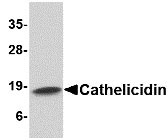Cathelicidin Antibody
- 产品详情
- 实验流程
- 背景知识
Application
| WB, IF, E, IHC-P |
|---|---|
| Primary Accession | P49913 |
| Other Accession | NP_004336, 39753970 |
| Reactivity | Human |
| Host | Rabbit |
| Clonality | Polyclonal |
| Isotype | IgG |
| Calculated MW | 19301 Da |
| Concentration (mg/ml) | 1 mg/mL |
| Conjugate | Unconjugated |
| Application Notes | Cathelicidin antibody can be used for detection of Cathelicidin by Western blot at 1 µg/mL. Antibody can also be used for immunohistochemistry starting at 5 µg/mL. For immunofluorescence start at 20 µg/mL. |
| Gene ID | 820 |
|---|---|
| Other Names | Cathelicidin antimicrobial peptide, 18 kDa cationic antimicrobial protein, CAP-18, hCAP-18, Antibacterial protein FALL-39, FALL-39 peptide antibiotic, Antibacterial protein LL-37, CAMP, CAP18, FALL39 |
| Target/Specificity | CAMP; |
| Reconstitution & Storage | Cathelicidin antibody can be stored at 4℃ for three months and -20℃, stable for up to one year. As with all antibodies care should be taken to avoid repeated freeze thaw cycles. Antibodies should not be exposed to prolonged high temperatures. |
| Precautions | Cathelicidin Antibody is for research use only and not for use in diagnostic or therapeutic procedures. |
| Name | CAMP (HGNC:1472) |
|---|---|
| Function | Antimicrobial protein that is an integral component of the innate immune system (PubMed:14978112, PubMed:16637646, PubMed:18818205, PubMed:22879591, PubMed:9736536). Binds to bacterial lipopolysaccharides (LPS) (PubMed:16637646, PubMed:18818205). Acts via neutrophil N-formyl peptide receptors to enhance the release of CXCL2 (PubMed:22879591). Postsecretory processing generates multiple cathelicidin antimicrobial peptides with various lengths which act as a topical antimicrobial defense in sweat on skin (PubMed:14978112). The unprocessed precursor form, cathelicidin antimicrobial peptide, inhibits the growth of Gram-negative E.coli and E.aerogenes with efficiencies comparable to that of the mature peptide LL-37 (in vitro) (PubMed:9736536). |
| Cellular Location | Secreted. Vesicle. Note=Stored as pro-peptide in granules and phagolysosomes of neutrophils (PubMed:7529412, PubMed:9736536). Secreted in sweat onto skin (PubMed:14978112). |
| Tissue Location | Expressed in neutrophilic granulocytes (at protein level) (PubMed:7529412, PubMed:7615076, PubMed:7890387, PubMed:8681941, PubMed:8946956, PubMed:9736536). Expressed in bone marrow (PubMed:7890387). [Antibacterial peptide FALL-39]: Expressed in bone marrow and testis. |
For Research Use Only. Not For Use In Diagnostic Procedures.
Provided below are standard protocols that you may find useful for product applications.
BACKGROUND
Cathelicidin Antibody: One component of host defense at mucosal surfaces is epithelial-derived antimicrobial peptides. Cathelicidins are one family of antimicrobial peptides characterized by conserved pro-peptide sequences that have been identified in epithelial tissues and some myeloid cells of humans and animals. LL-37/hCAP-18 is the only Cathelicidin found in humans and is expressed in inflammatory and epithelial cells. The presence of these molecules is essential for defense against invasive bacterial infection in skin. Besides their direct antimicrobial function, Cathelicidins have multiple roles in mediating innate and adaptive immunity, such as endotoxin neutralizing, angiogenesis, wound healing and promoting neutrophil chemotaxis and mast cell recruitment. Finally, Cathelicidin antimicrobial peptides qualify as prototypes of innovative drugs that may be used to treat infection and/or modulate the immune response.
REFERENCES
Zaiou M and Gallo RL. Cathelicidins, essential gene-encoded mammalian antibiotics. J. Mol. Med. 2002; 80:549-61.
Agerberth B, Gunne H, Odeberg J, et al. FALL-39, a Putative Human Peptide Antibiotic, is Cysteine-Free and Expressed in Bone Marrow and Testis. Proc. Natl. Acad. Sci. USA 1995; 92:195-9.
Nizet V, Ohtake T, Lauthe X, et al. Innate antimicrobial peptide protects the skin from invasive bacterial infection. Nature 2001; 414:454-7.
Koczulla R, von Degenfeld G, Kupatt C, et al. An angiogenic role for the human peptide antibiotic LL-37/hCAP-18. J. Clin. Invest. 2003; 111:1665-72.
终于等到您。ABCEPTA(百远生物)抗体产品。
点击下方“我要评价 ”按钮提交您的反馈信息,您的反馈和评价是我们最宝贵的财富之一,
我们将在1-3个工作日内处理您的反馈信息。
如有疑问,联系:0512-88856768 tech-china@abcepta.com.























 癌症的基本特征包括细胞增殖、血管生成、迁移、凋亡逃避机制和细胞永生等。找到癌症发生过程中这些通路的关键标记物和对应的抗体用于检测至关重要。
癌症的基本特征包括细胞增殖、血管生成、迁移、凋亡逃避机制和细胞永生等。找到癌症发生过程中这些通路的关键标记物和对应的抗体用于检测至关重要。 为您推荐一个泛素化位点预测神器——泛素化分析工具,可以为您的蛋白的泛素化位点作出预测和评分。
为您推荐一个泛素化位点预测神器——泛素化分析工具,可以为您的蛋白的泛素化位点作出预测和评分。 细胞自噬受体图形绘图工具为你的蛋白的细胞受体结合位点作出预测和评分,识别结合到自噬通路中的蛋白是非常重要的,便于让我们理解自噬在正常生理、病理过程中的作用,如发育、细胞分化、神经退化性疾病、压力条件下、感染和癌症。
细胞自噬受体图形绘图工具为你的蛋白的细胞受体结合位点作出预测和评分,识别结合到自噬通路中的蛋白是非常重要的,便于让我们理解自噬在正常生理、病理过程中的作用,如发育、细胞分化、神经退化性疾病、压力条件下、感染和癌症。








